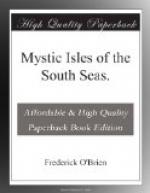We had another picnic; this time at Papenoo. Polonsky owned thirty thousand acres of land in the Great Valley of Papenoo, the largest of all the valleys of Tahiti. He had bought it from the Catholic mission, which, following the monastic orders of the church in other countries for a thousand years, had early adopted a policy of acquiring land. But there were too few laborers in Tahiti now. Christianity had not worked the miracle of preserving them from civilization. The priests were glad to sell their extensive holdings at Papenoo, and the energetic Russo-French count said that he would bring Slav families from Europe to populate and develop it. He would plant the vast acreage in cocoanut-trees, vanilla vines, and sugar-cane, and build up a white community in the South Seas. He had noble plans for a novel experiment.
We started from the Cercle Bougainville in the afternoon in carriages pulled by California bronchos. The dour Llewellyn, the handsome Landers, the boastful McHenry, Lying Bill, David, the young American vanilla-shipper, Bemis, an American cocoanut-buyer, the half-castes of the orchestra, and servants, filled three roomy carryalls. The ideal mode of travel in Tahiti in the cool of the day would be a donkey, a slow, patient beast, who might himself take an interest in the scenery, or at least the shrubbery. But the white must ever go at top speed, and we dashed through the streets of Papeete, the accordions playing “Revive us again!” the “Himene Tatou Arearea,” and other tunes, and we singing, “Hallelujah! I’m a bum!” and “Faararirari ta oe Tamarii Tahiti! La, li!” One never makes merry privately in the South Seas.
Through Papeete we went along the eastern Broom Road, our train attracting much attention. We stopped at the glacerie for ice, and Polonsky insisted that we make a detour to his residence to drink a stirrup-cup of champagne. He donned riding-breeches and took a horse from his well-appointed stable.
Against the road on each side were close hedges of acalypha, or false coffee, called in Tahitian tafeie, a small tree which grows quickly, and the leaves of which are red or bronze or green, handsome and admirably suited for fencing. Through these hedges and the broad entrances I saw the houses and gardens, the residents and family life of the people. Everywhere was a small prosperity, with gladness; pigs and sheep cropping the grass and herbs, which were a mat of green, rising so fast with the daily showers that only flocks could keep it shorn. On the verandas and on the turf idle men and women were gazing at the sky, talking, humming the newest air, plaiting hats, or napping. No one was reading. There was no book-store in Tahiti. I had not read a line since I came. I had not stepped up to the genial dentist’s to see an American journal. After years of the newspaper habit, reading and writing them, it had fallen away in Tahiti as the prickly heat after a week at sea. Of what interest was it that the divorce record was growing longer in New York, that Hinky Dink had been reelected in Chicago, and that Los Angeles had doubled in population. A dawn on the beach, a swim in the lagoon, the end of the fish strike, were vastly more entertaining.




